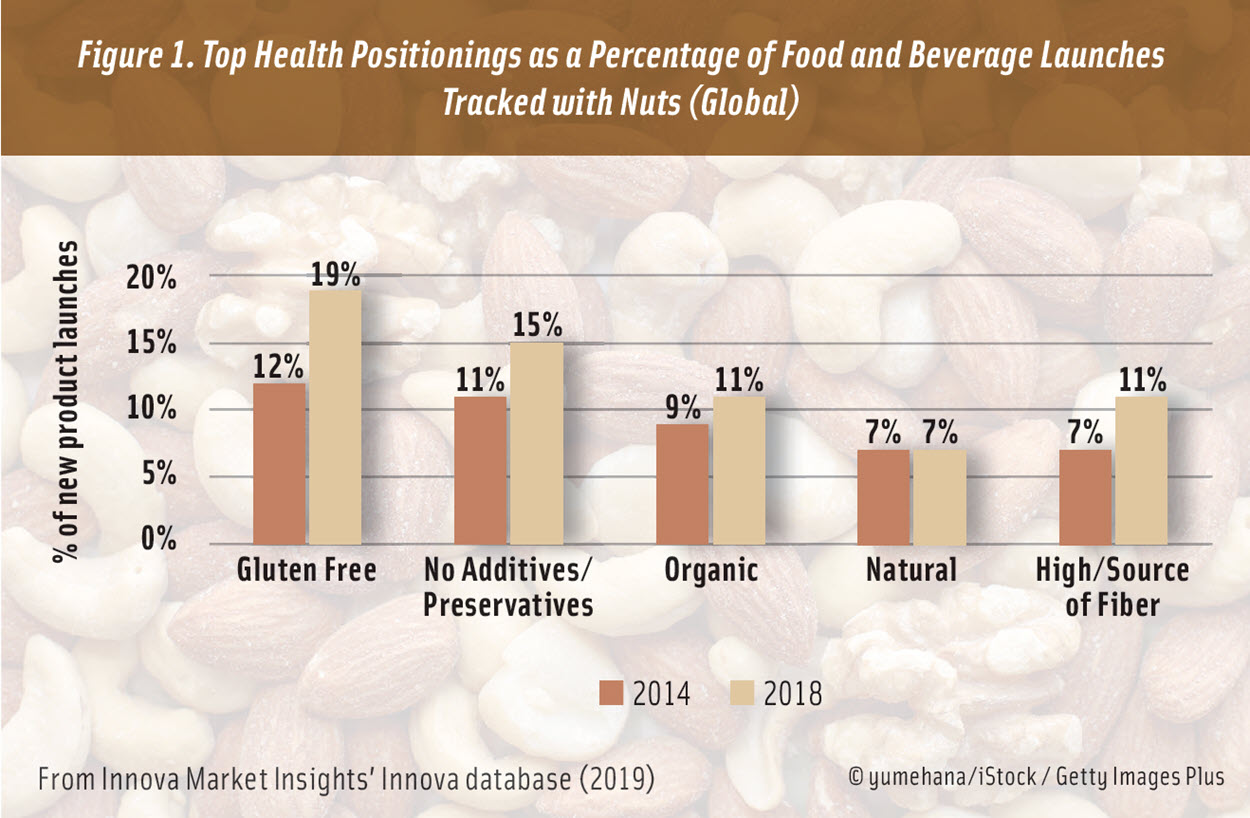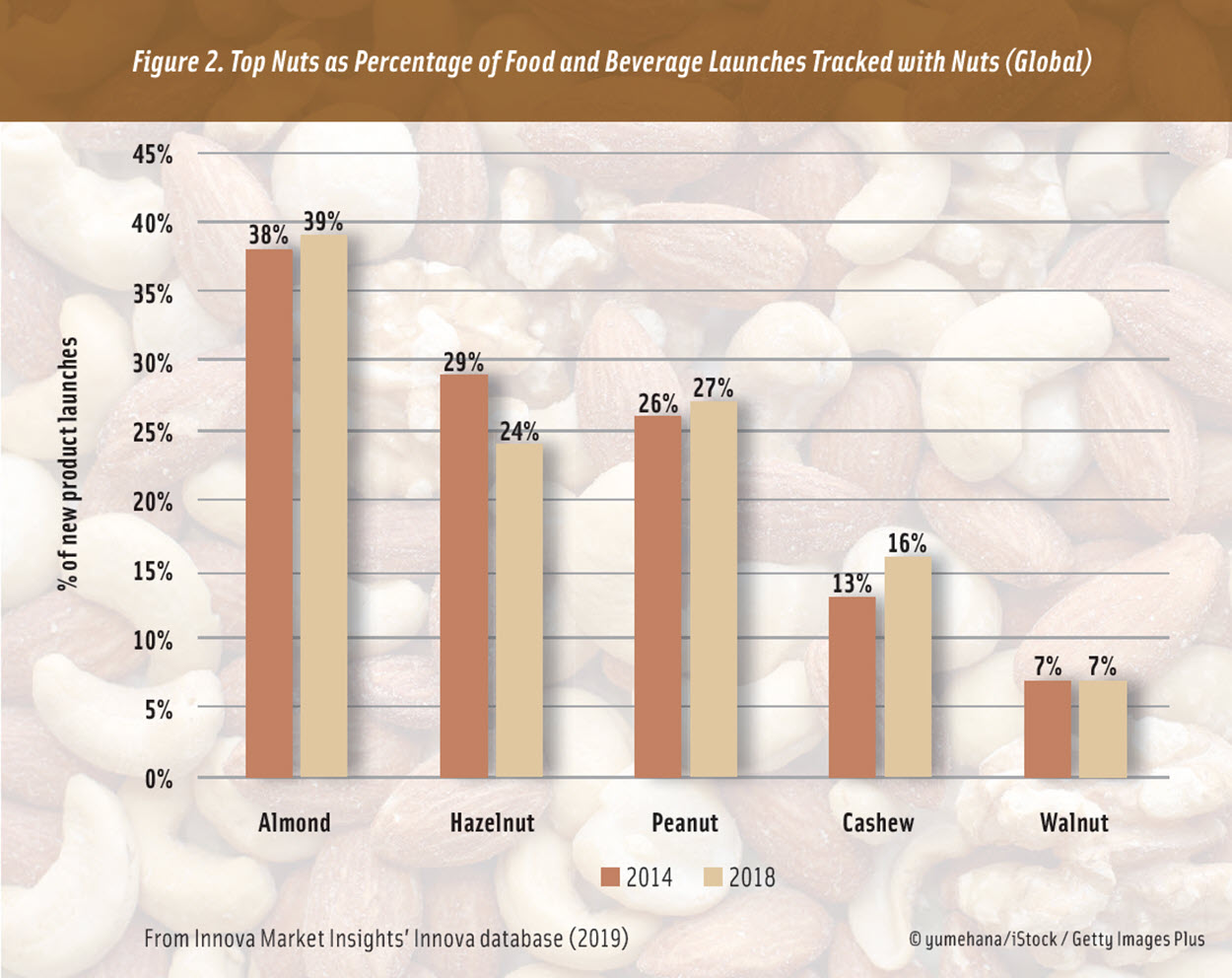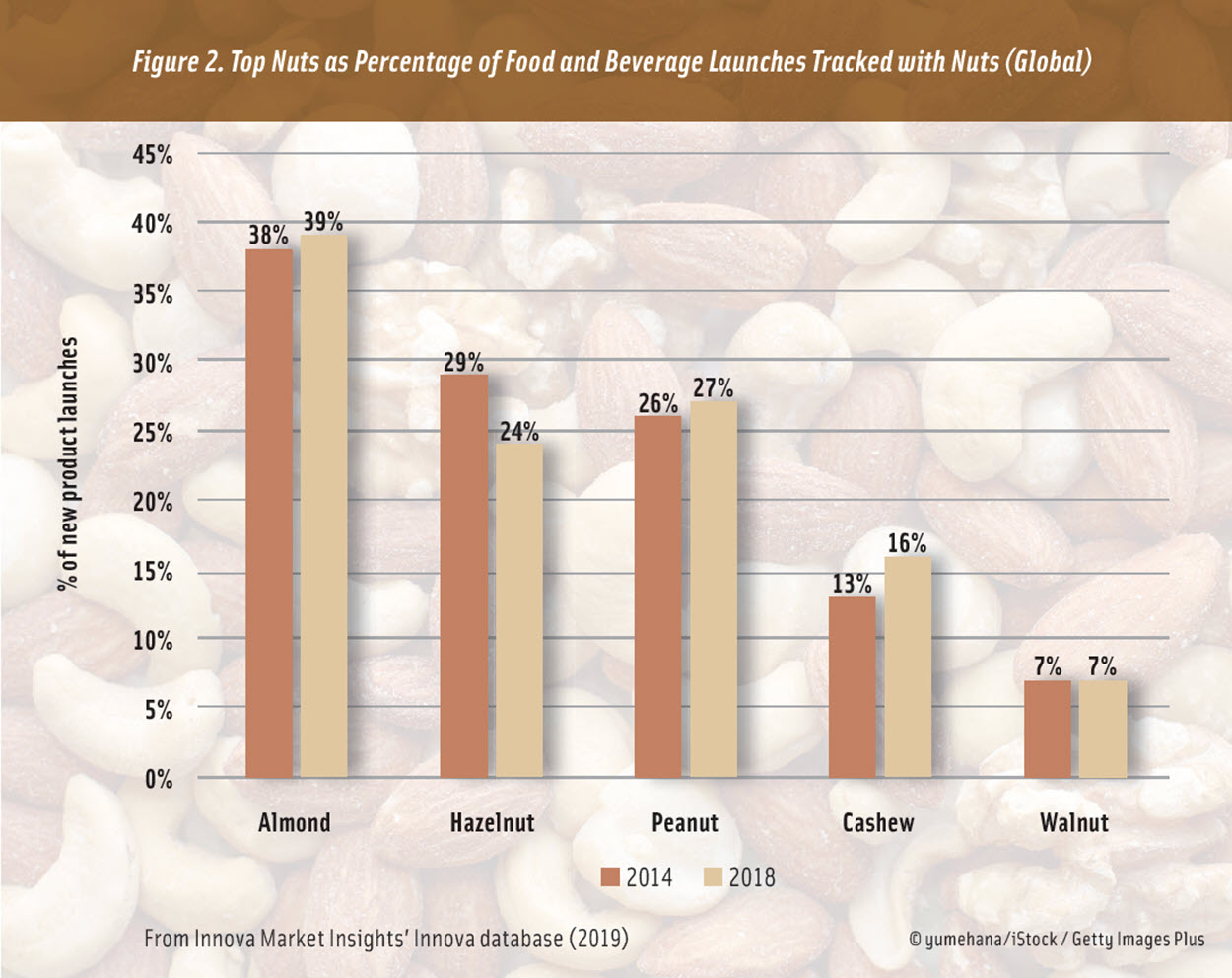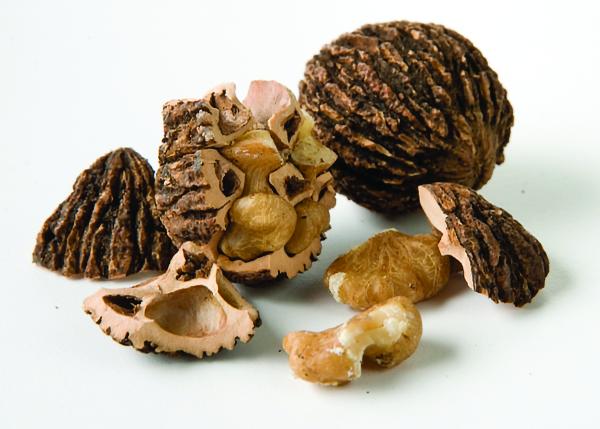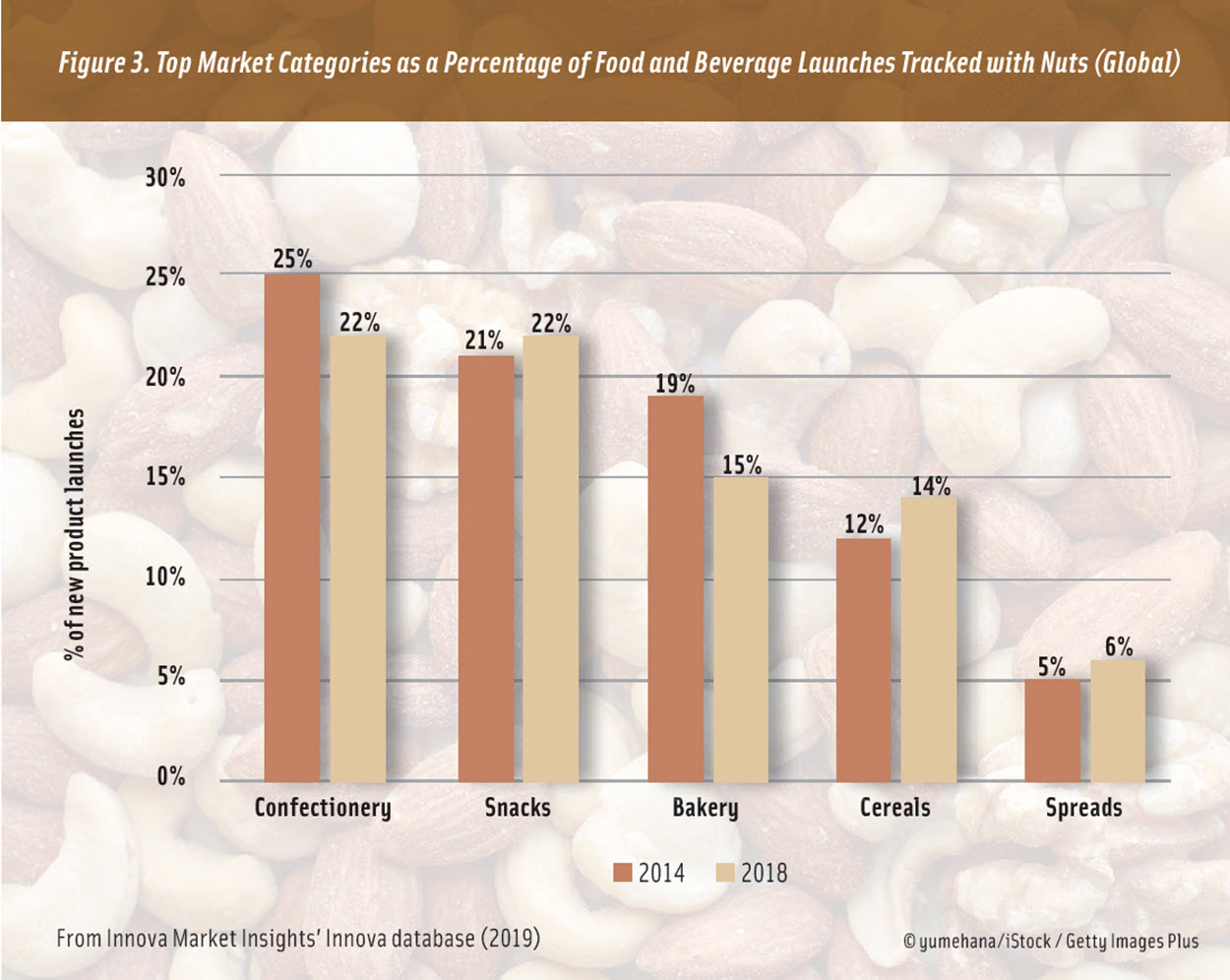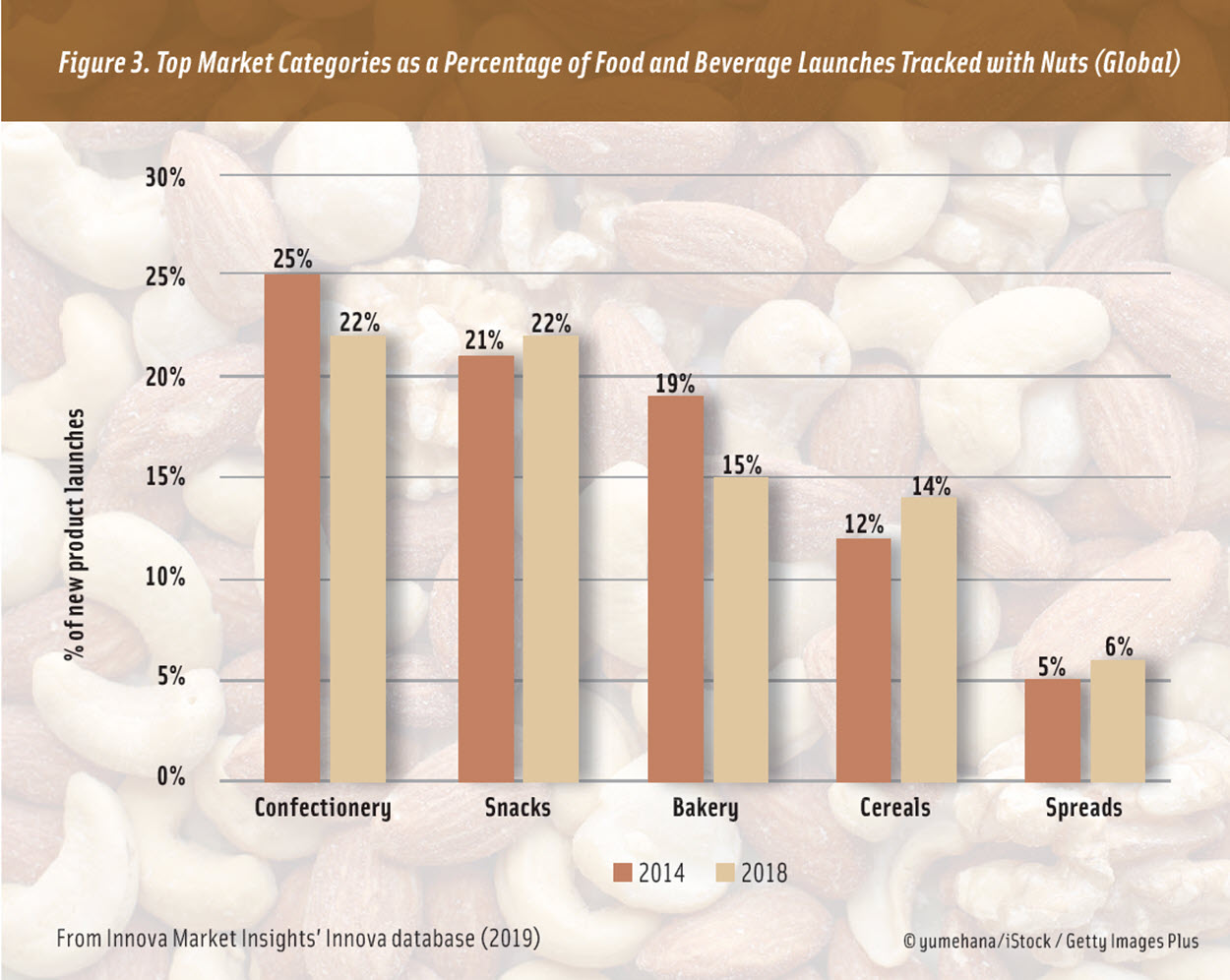Go Nuts
INGREDIENTS
Nuts are nutritional power-houses, containing nutrients like protein, fiber, and various vitamins and minerals. That’s one of the reasons why U.S. consumers surveyed by Innova Market Insights listed nuts as the No. 2 food that they choose when they want a healthy snack (fresh fruits and vegetables were the top choice). Nuts also serve as functional ingredients, contributing to the texture, mouthfeel, and flavor of food and beverage products of all sorts.
Thanks to product developers who explore the versatility of nuts, there’s an array of food and beverage products across categories that feature nuts and nut ingredients that go beyond the usual bars, cereal, and nut snack packs. Nut milks made from almonds and cashews, for instance, are used in dairy-free yogurt from Kite Hill and Forager Project and nondairy frozen desserts from So Delicious Dairy Free and Valsoia. Almond flour is used in Simple Mills crackers, Siete Family Foods grain-free tortillas, and Bob’s Red Mill paleo pancake and waffle mix. Among the various nut milks, Three Trees makes one from pistachios. And bread from Food for Life is made with pecan meal, a spicy queso dip from Siete Family Foods features cashews blended with cheese and spices, and a version of potato chips from Kettle Brand is fried in almond oil.
Nuts Suit Gluten-Free, Plant-Based Diets
The top positionings for products with nuts are gluten-free and no additives/preservatives, according to information provide by Innova Market Insights. This makes sense as nut flours like almond flour can stand in for traditional flours in some gluten-free bakery formulations, and dairy alternatives like almond, cashew, and hazelnut milks replace cow’s milk and soy milk to create dairy-free, soy-free smoothies, yogurts, and ice cream. When looking at a specific type of nut-containing product—nut and seed snacks—data from the research firm show that key positionings run the gamut from clean options to holistic health and include natural, low-sodium/low-cholesterol, and high-fiber/high-protein.
Of course, nuts are a perfect fit in plant-based product innovation. One area is in dairy alternative beverages, and Innova points out three noteworthy products released in 2019. An Innova analyst calls Nutty Bruce Roasted Almond and Oat Milk, “an organic dairy alternative drink, made using a blend of roasted almonds and oats,” adding that it offers “a clean label approach combined with a creamier texture than traditional nut milks.” Another dairy alternative is Three Trees Organic Black Sesame Nut and Seedmilk (the nut used is almond). The third product example is Dahilcious Organic Dairy Free Cashew Probiotic Yogurt, a drinkable dairy-free yogurt with probiotics and 5 grams of protein.
Almonds Abound in New Products
Almonds lead the way as the top nut used in global new product introductions in 2018, according to Innova Market Insights. Europe is the largest region with a 45% share of introductions of new products with almonds, and Asia-Pacific is the fastest-growing region in terms of almond introductions, as the firm’s 2018 Global New Product Introduction Report shows.
Experts in the almond industry point to several consumer and product development trends as influencers of the popularity of almonds. One expert sees plenty of growth opportunities for almond ingredients across plant-based, clean label, and indulgent snack products. “As consumers are increasingly mindful about the foods they consume, product developers have a unique opportunity to create innovative products that satisfy the desire to snack while on the go, enjoy an indulgent yet free-from dessert or consume plant-based and clean label foods,” says Harbinder Maan, associate director of trade marketing and stewardship at the Almond Board of California.
Echoing these statements, Jeff Smith, director of marketing at Blue Diamond Almonds Global Ingredients Division, says that given these trends, he is not surprised that the global demand for almonds has been very strong and that it is expected to grow. “Almonds check all the boxes as an ingredient, combining proven nutritional benefits with a mild, pleasant taste profile that formulators—and consumers—love. Almonds also deliver essential nutrients that may be lacking from a plant-based diet, such as protein and calcium.”
Both Maan and Smith say that the use of almonds in foods and beverages is moving beyond the traditional applications like bakery and snacks. Maan says that while the top three categories for new almond products globally are confectionery, snacks, and bars, almonds are increasingly being used in other categories, including spreads, dairy, and desserts/ice cream. “This indicates consumers are demanding almonds across new and non-traditional categories.”
Functional foods and nutraceuticals are areas in which almond use is expanding, says Smith, who mentions Blue Diamond Almond Protein Powder as a key almond ingredient. “With a clean taste, smooth texture, and abundant health benefits, Blue Diamond Almond Protein Powder is perfectly positioned to take advantage of growing consumer interest in health and wellness products that feature added protein and plant-based ingredients.” The almond protein powder is ideal for use in protein-enhanced nutrition bars, protein smoothies and shakes, and more. Smith adds that the powder is an excellent source of magnesium, phosphorous, manganese, and copper and a good source of protein, fiber, potassium, calcium, iron, and zinc. Almond Protein Powder is also dairy-free, gluten-free, soy-free, and is not genetically modified, making it well suited for consumers with a range of dietary needs who may be transitioning to a cleaner, plant-based diet, he adds.
There are more examples of how products developers and chefs are get-ting creative with almonds and almond ingredients. “Product developers have introduced flavored almond milk blends that tap into floral food trends and glob-ally inspired flavors, such as rose and chai,” says Maan. “We’re also increasingly seeing almond milk and butter used in clean label, plant-based products, from smoothies that blend the two for an indulgent beverage to gluten-free donuts, breads, and coatings.”
The Almond Board of California earlier this year conducted a food trends tour of Nashville, Tenn., where chefs incorporated almonds into one-of-a-kind dishes and reimagined classic applications to feature almonds. These ranged from savory sauces to sweet desserts and nutrient-rich beverages. “Nashville boasts a food scene where chefs and product developers are combining local traditions with haute techniques to redefine ‘Southern fare,’ and we found that the versatility and popularity of almonds resulted in them being partnered with edgy flavors and unexpected ingredients to create unique dishes and beverages,” says Maan. “For example, Five Daughters [Bakery] produces paleo donuts, which are free of grains, gluten, dairy, and sugars and are made from almond flour for a premium, clean label take on a popular breakfast, snack, or dessert. At The Mockingbird, we sampled almond milk poached chicken with almond mole and almond quinoa crunchies, a demonstration of the versatility of almonds in globally inspired cuisine.”
Some other standouts included baked apple toast with roasted almond butter and various bowl concepts made with almond milk and almond butter from E + Rose Wellness Cafe and lamb osso bucco with an almond and caramelized onion sauce from Chauhan Ale & Masala House. There was a dark chocolate con-fection with jalapeno roasted almonds dusted with chipotle powder from Colts Chocolate, several cold-pressed juices made with almonds from Juice Nashville, and turnips topped with almond pesto from Butcher & Bee. Fountains of Juice served up several housemade cold-pressed beverages that combined almonds with turmeric root, ginger, black sesame seed, activated charcoal, vanilla, coconut nectar, and raw cacao.
“Due to their versatility, texture, and popularity among consumers, almonds really are an ideal ingredient for product and recipe development,” says Maan. “Almonds offer a subtle flavor that complements on-trend ingredients, and by playing with roasting at different temperatures, product developers can attain varying levels of nuttiness. Depending on the form, almonds’ creamy or crunchy texture brings a premium feel to sweet and savory applications, such as almond butter as a coating, or sliced almonds as a topping.”
Lastly, Maan mentions that the California almond community has committed itself to sustainable growing practices and a “rigorous” pasteurization program, which together give product developers and chefs a consistently safe and stable supply of almonds.
Black Walnut Inspiration
A uniquely American tree nut, the black walnut gives a bold and distinct flavor to food products and menu concepts. A completely wild crop, American black walnuts grow throughout the Midwest and East Central United States and are hand-harvested every fall by Missouri-based Hammons Products Co. (They are one of a few crops still picked by hand, according to the company.) The flavor is bold and earthy, with a creamy finish, and does not have the slight bitterness that English walnuts can have, making the nut a perfect ingredient for use in many food categories. “Currently, two major applications for black walnuts are in consumer baking and as an ice cream inclusion,” says Jacob Basecke, vice president of sales and marketing at Hammons Products Co. “These markets will continue to be pillars for consumption, but the growth will come from new products in health-focused and plant-based formulations. Protein bars, butters, healthy snacks, and powders are a few of the categories that we’ll see the most growth in.”
Currently, the company processes black walnut nutmeat pieces and black walnut oil, and it is developing a black walnut powder that is high in protein for use in powder formulations, beverage applications, and as a flour alternative for baking, says Basecke. It’s no surprise that the demand for plant-based eating options is driving this development. “The plant-based protein market is only growing so we want to leverage our ability to provide black walnuts, which is the high-est protein nut with 57% more protein compared to English walnuts,” says Basecke. “Almonds are a good example of a tree nut that has been very successful in breaking into new markets because of their nutritional profile and versatility. Product developers and innovations teams are always looking for new ingredients, different flavors, and added nutrition. The overall nutritional composition of black walnuts makes them stand out from other nuts and has significantly increased opportunities to introduce them in new food applications. We are only scratching the surface when it comes to new innovations, so it’s a very exciting time for black walnuts.”
As far as nutrients are concerned, black walnuts are high in protein, phytosterols, and antioxidants. In a first-of-its-kind study completed in 2018, researchers at the University of Missouri confirmed that black walnuts contain phytosterols, which have been shown to help prevent obesity, diabetes, and cardiovascular disease while promoting lower cholesterol, lower inflammation, and anticancer activity in the body, according to information from Hammons. Phytosterols have previously been found in English walnuts, but researchers discovered black walnuts are a richer source of the health-promoting molecule.
For curious culinarians, try any of the company-tested recipes that incorporate black walnuts. (They’re also great inspiration for product developers.) Of course, there are recipes for ice cream and cake, applications where the taste and texture of black walnuts stand out. But also consider using chopped pieces in coatings and breadings for meat and fish or blended to make sauces and pesto. Mix toasted chopped black walnuts into pumpkin pie filling or swap out peanuts for black walnuts in brittle. Use expeller-pressed roasted black walnut oil in dressings.
Basecke notes that black walnuts have been used in some craft beers and extracts from the shells have been used in flavorings.
Functional Peanut Ingredients
Peanuts are the No. 1 snack nut consumed in the United States, accounting for two-thirds of the snack nut market, and peanut butter is the leading use of peanuts produced in the United States, according to the American Peanut Council. But there’s more to peanuts than a popular snack at baseball games and the base for a lunchtime staple. Peanuts and peanut ingredients are delicious and functional additions to many food and beverage applications.
Take peanut flour for instance. “Because of its clean label, protein-packed attributes as well as its flavor, aroma, and ability to bind fat and extend product shelf life, peanut flour usage has increased,” says Ali Hill, vice president of sales, processing & specialty products, at Golden Peanut and Tree Nuts, a subsidiary of Archer Daniels Midland Co. Peanut flour is a high source of protein, and Golden Peanut and Tree Nuts offers two options: one at 40% protein and the other at 50% protein. The company is currently collaborating with some of its customers to develop new food and beverage products that incorporate peanut flour as a source of protein, Hill says. The 100% peanut flours that the company offers also come in different roast levels, with each suited to complement certain ingredients and applications.
Peanut flour is increasingly being used in handheld nutritional, snack, and breakfast bars, ready-to-drink protein beverages, cereals, and confectionery, where it is often used to boost flavor, bind fat, and increase protein, says Hill. An unexpected and emerging use for peanut flour that she mentions, is in craft beer brewing, where it can be used to brew peanut butter–flavored beer. “Golden Peanut and Tree Nuts produces a low-fat, ready-to-use peanut flour for craft brewing. The low fat content is important since ingredients with high fat or lipid levels can affect the fermentation process by inhibiting ester formation. Golden Peanut and Tree Nuts all-natural gluten-free peanut flour does not require pasteurization and can be used through-out the brewing process to add a roasted aromatic flavor.”
Hazelnuts Move Beyond Spreads
The healthy image of hazelnuts continues to generate interest; 88% of consumers view hazelnuts as somewhat or very healthy, according to a consumer research study (Hazelnut Industry 2017). One of the findings explains the potential to affect consumption patterns: “Awareness of health benefits specific to hazelnuts motivates consumers to eat more of the nut, especially when they are linked to improved heart health or disease prevention.”
Of course, another of the trends that is sweeping the food industry is also contributing to the growing popularity of hazelnuts. “The current trend of formulating with plant-based ingredients or for plant-based products provides exciting opportunities for nutrient-rich ingredients such as Oregon Hazelnuts,” says Mark Clute, quality assurance manager at Hazelnut Growers of Oregon. “As the leader in U.S. hazelnuts, Hazelnut Growers of Oregon has seen a significant interest in value-added ingredients such as hazelnut butter and paste; sliced, diced, and floured hazelnuts; and even whole hazelnut kernels,” says Clute. “This is due to the interest in the high protein level, trace minerals such as potassium, and high levels of monounsaturated fats that help with weight loss, reduce the risk of heart disease, and decrease inflammation.”
Nearly all (99%) of the hazelnuts grown in the United States are grown in Oregon, according to the Hazelnut Industry Office, and these nuts are available in whole form and are processed into halves, pieces, diced, slices, meal/flour, and paste/butter formats for product developers. The most popular formats of hazelnuts are as butters or pastes in variegates, spreads, and as flavor notes; diced for use on or included in baked goods; and as flour to improve the nutritional profile of the finished product, says Clute.
Examples of products are M&M’s Hazelnut Spread Chocolate Candies, two different Jif hazelnut spreads, and hazelnut-flavored International Delight coffee creamer.
“This expanding interest in plant-based products and healthy nuts has brought Hazelnut Growers of Oregon to recently introduce a new line of seasoned hazelnuts to the retail market that includes exciting flavors, such as Southwest Chili Pepper, Himalayan Salt, Sweet and Spicy BBQ, Rosemary, and Cinnamon Sugar,” says Clute.
The rich flavor and crisp texture of hazelnuts is found in the carbohydrate fraction rather than in the kernel fat, and this makes the flavor of hazelnuts more easily extracted and concentrated, according to the Hazelnut Industry Office. To intensify the flavor, the organization recommends roasting, chopping, or grinding hazelnuts. Consumer research from the Hazelnut Industry Office shows that chocolate, caramel, and coffee are the top three flavor pairings with hazelnuts, followed by vanilla, sea salt, and coconut. The report also offers up other flavor combinations consumers cited that might be worth considering in product development efforts. These include ones that work in sweet applications (banana, cinnamon-sugar, honey, berry, pumpkin spice, apple pie, apple, coffee liqueur, cherry, and gingerbread) and in savory applications (hickory-smoked, garlic, Cajun, barbecue, Parmesan cheese, bacon, and chipotle honey). The Hazelnut Industry Office pro-motes hazelnut-based recipes, including hazelnut grits, toasted hazelnut polenta, hazelnut Romesco sauce, hazelnut spaetzle, and hazelnut-coffee pot du crème with chocolate ganache and hazelnut shell smoked marshmallow.
“Hazelnuts lend themselves to various creative opportunities for use in food and beverage products,” says Clute. “These include adding them to the fermentation processes for hazelnut beer, wine, and hard liquor, blending hazelnut oil with other oils to impact the flavor profile, and creating innovative snack items. As consumers continually look for new and innovative products, hazelnuts’ attributes are ideal for product formulators due to their nutritional profile and malleable nature.”
references
Dean, L. L., C. M. Klevorn, and B. J. Hess. 2016. “Minimizing the Negative Flavor Attributes and Evaluating Consumer Acceptance of Chocolate Fortified with Peanut Skin Extracts.” J. Food Sci. 81(11):2824–2830.
Hazelnut Industry. 2019. Oregon Hazelnuts: A Flourishing Supply & Burgeoning Consumer Interest Present an Opportunity to Innovate. Hazelnut Industry Office. Aurora, Ore. oregonhazelnuts.org.
Food Technology Articles

Tapping Into the Power and Potential of Bioactives
As bioactive ingredients move closer to mainstream applications, proponents work to advance awareness of their benefits.
Frozen Fusion: Asian Inspirations Stirring a Sensation
Teriyaki, biryani, dumplings, sushi, kimbap, and more are on a roll behind the freezer door.
Healthy Food Ingredients: The Next Generation
This column covers how artificial intelligence can be used to create efficiencies in development and production as well as find new sources of nutritional ingredients, and how precision fermentation opens the door to developing ingredients that are eco-friendlier and more sustainable.
Better Juice and Ingredion Collaborate and More Ingredient News
News about food industry suppliers
How to Formulate for Food Intolerances
In this column, the author describes the global prevalence of food intolerances and provides insight into state-of-science ingredient replacement and removal methods when formulating gluten-free and lactose-free foods.
IFT Podcasts

EP 3: The Fuzzy Front End of Product Development
How human connection drives trends. Where do businesses start when they want to develop a new product and how do you know this product will be a hit with consumers?
Episode 28: Spicing Up the Future of Food
In this podcast we’ll focus on some of nature’s herbs, spices and the extracts that offer potential health benefits. We'll also talk with the article's author, Linda Ohr, about what the research tells us, as well as some entrepreneurial companies who have tapped these spices' hidden potential for their current and future product innovation.





